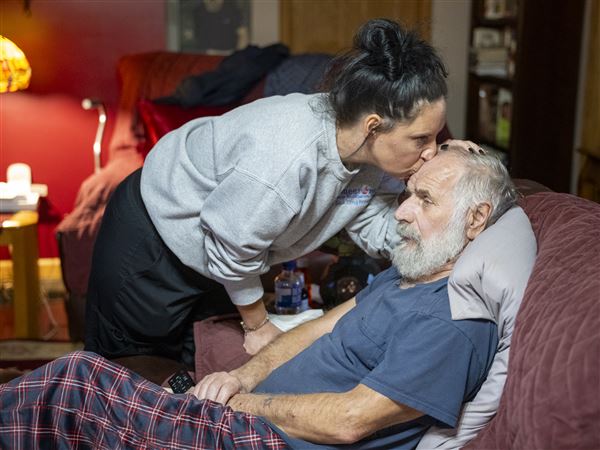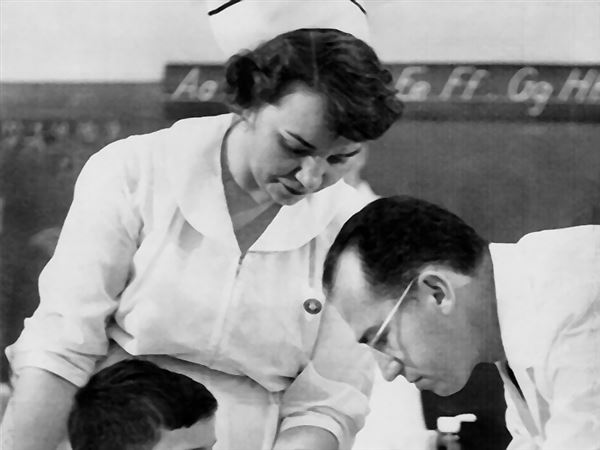Lea Ann Marlow wasn't alone among physicians who doled out painkillers like lollipops and attracted a devoted interstate patient population. She may have been the only one brazen enough to claim to be pharmaceutical royalty.
According to medical licensing disciplinary documents on file in Kentucky and Indiana, Marlow in 2012 wrote prescriptions for 447,992 tablets of oxycodone, a highly addictive drug that 95 percent of her patients received.
Following a mid-year crackdown in Kentucky, she moved to Indiana, driving a car decorated with a vanity plate reading “Tilulae Regina.” Asked by medical investigators what that meant, she testified that it's Latin for “pill queen.”
In Kentucky, one could indeed live like a monarch by prescribing pills -- for a while.
For instance, the painkiller prescription distributorship run by one physician, James Alvin “Ace” Chaney, 51, of Hazard, grossed $23.4 million from 2006 through 2014 -- including $15.8 million billed to Medicare and Medicaid -- according to federal prosecutors. He and his wife amassed five pieces of real estate; seven cars including a Bentley Continental, a Dodge Viper and a Hummer H2; a Harley Davidson motorcycle; a Beechcraft King Air 200 Airplane and a hangar. They face sentencing in August.
Officials said the pill magnates left behind shortened or ruined lives.
“As it stands, today -- statistically -- three Kentuckians are going to die from an accidental overdose,“ said Van Ingram, executive director for the Kentucky Office of Drug Control Policy. To the “minority of prescribers” that feed addiction, his message is, ”If you played a part in that, shame on you.”
Mommy, should I pee in the cup?
In the bluegrass state, annual drug overdose deaths quadrupled from 2000 to 2010, when they broke the 1,000-per-year mark, according to the Kentucky Injury Prevention and Research Center. A few doctors were accused of roles in double-digit numbers of deaths.
In 2011, Danny Finley became coroner of Clay County, population 21,013, which bills itself as the “Gateway to Elk Country.” That year, Mr. Finley said in an interview, he classified 43 fatalities as drug-related. Eleven of those deaths, he told the board, were patients of psychiatrist Melborne A. Williams.
The board's check of Kentucky's prescribing database indicated that Dr. Williams had prescribed 1.35 million doses of the sedative Xanax in a single year -- tops among the state's doctors, according to a board order which Dr. Williams signed in 2012.
“I treated a lot of anxiety and depression,” Dr. Williams, now 70, said in an interview with the Post-Gazette. “I found that a lot of patients benefitted from Xanax and antidepressants.”
He said he knew that abusers liked the sometimes-deadly mix of Xanax and opioids, but he did not prescribe the latter, and tried to use drug tests to identify addicts and steer them to treatment.
Investigators, though, said patients blatantly cheated on the tests. A former colleague of Dr. Williams told an investigator that, “a child was heard asking, 'Mommy, do you want me to pee in a cup again?'”
The board suspended Dr. Williams’ license to practice. “I had about five minutes to explain,” he said, and “they had already made up their mind.” He never returned to work.
He noted that “no accusations, criminal or civil, were brought against me. … To say that I killed 12 patients, I wouldn't even be talking to you right now. I'd be in a federal prison if there were any truth to that."
Mr. Finley said his county’s drug death toll dropped steadily after 2011, to a low of 10 in 2014.
Not rainbows and puppies
Why did drugs take hold in Elk Country?
“In much of Eastern Kentucky, the workforce is engaged in difficult, manual labor,” like mining, farming and logging, said U.S. Attorney Kerry B. Harvey, of the state’s Eastern District. “So people would injure themselves and be prescribed these very potent narcotics, because the medical profession changed the way it looked at prescribing these kinds of narcotics for pain.”
The narcotics dulled the “sense of hopelessness” about the area’s economy, said Mr. Harvey. “And so for whatever reason, this sort of culture of addiction took hold.”
By 2012, Kentucky had 76 pain clinics, according to Mr. Ingram. That year Kentucky legislators, swamped with calls from the families of overdose victims, decided to rein in the pain economy.
The state already had a database of narcotic prescriptions, but many physicians weren’t checking it before prescribing, and so didn’t know whether their patients were getting narcotics from multiple sources. House Bill 1, passed in April 2012, made it mandatory for doctors to check the database before recommending certain drugs, and demanded that they get 4.5 hours of education on prescribing every two years.
The bill demanded that physicians do a physical examination, take a full medical history, make a plan and set up urine drug screens before prescribing powerful painkillers. It placed new requirements on pain clinics, and 32 of them “left in the middle of the night,” said Mr. Ingram.
The Board of Medical Licensure, from 2011 through 2015, took disciplinary action for prescribing irregularities against 135 of the state’s roughly 10,600 doctors. The board also moved against 33 doctors during that time for abusing narcotics themselves.
The result? Kentucky’s per capita opioid consumption -- though still seventh in the nation -- dropped by a steepest-in-Appalachia 12.5 percent from 2012 to 2014, according to IMS Health Inc. Kentucky is the only state, among the seven studied by the Pittsburgh Post-Gazette, in which fatal overdoses have plateaued. Elsewhere, they have climbed relentlessly.
Marlow, the pill queen, was among at least 20 Kentucky physicians charged with federal crimes in relation to their narcotics prescribing practices from 2011 through 2015. She served a three-year sentence, and could not be reached for comment.
Mr. Harvey said that as physicians have gone to jail, and others have faced board discipline, the painkiller business model has adapted.
“A few years ago, the typical pill mill case would be some rogue pain clinic with drug addicts lined up out the door into the parking lot,” with everyone paying cash, said Mr. Harvey.
Now the doctors take insurance, and bill the insurer or the government not just for the office visit, but for the MRI, urine screen and back brace they use to justify the addictive narcotic.
“So instead of a cash business, in many cases now the taxpayers or the insurance companies pay,” said Mr. Harvey. “The result is the same. We end up with our communities flooded with these very potent prescription narcotics.”
Rich Lord: rlord@post-gazette.com, 412-263-1542, @richelord. Adam Smeltz asmeltz@post-gazette.com, @asmeltz.
Read OVERDOSED: How doctors wrote the script for an epidemic. Email the team at overdosed@post-gazette.com, and read the OVERDOSED blog for more on the Post-Gazette's investigation, readers' stories, and the latest news about the drug epidemic.
First Published: May 24, 2016, 4:00 a.m.
Updated: May 24, 2016, 4:05 a.m.

















